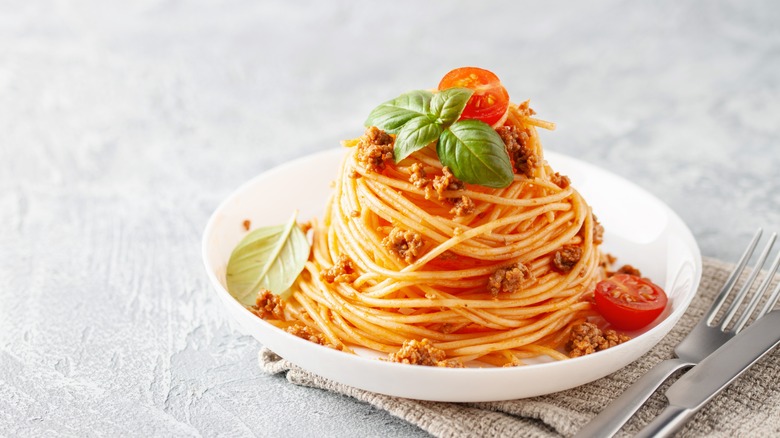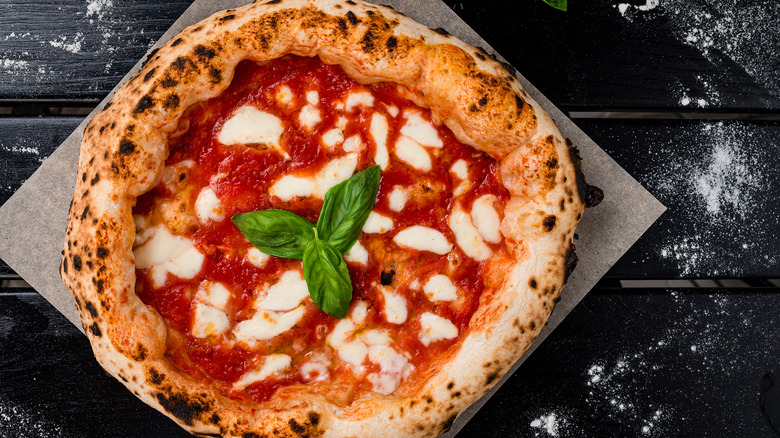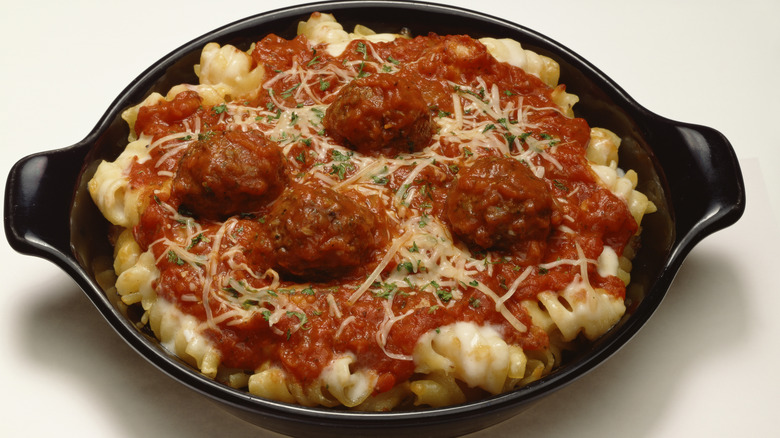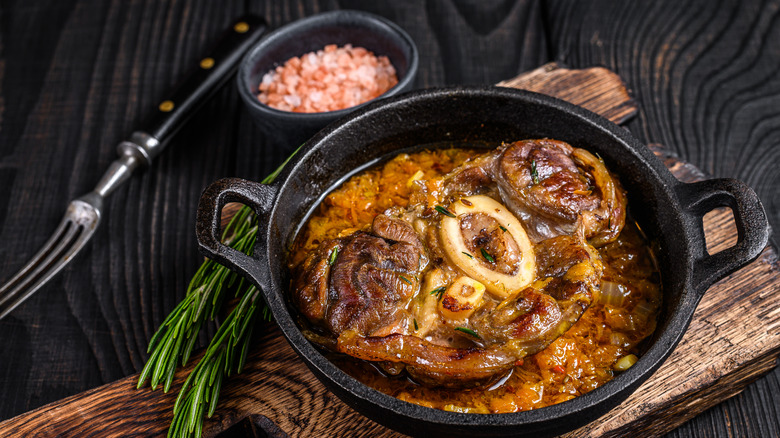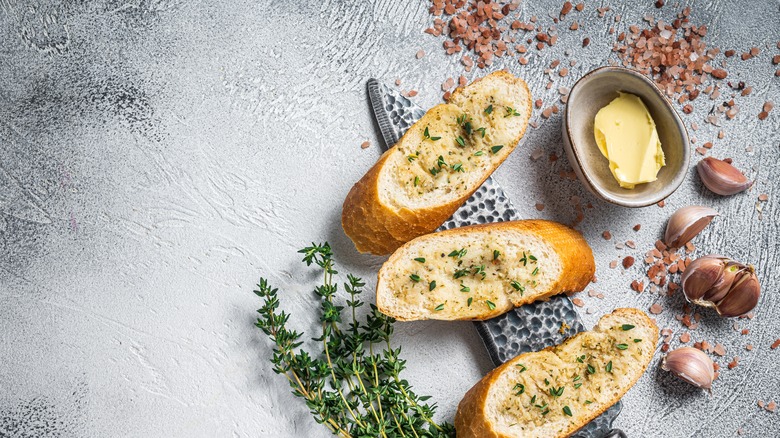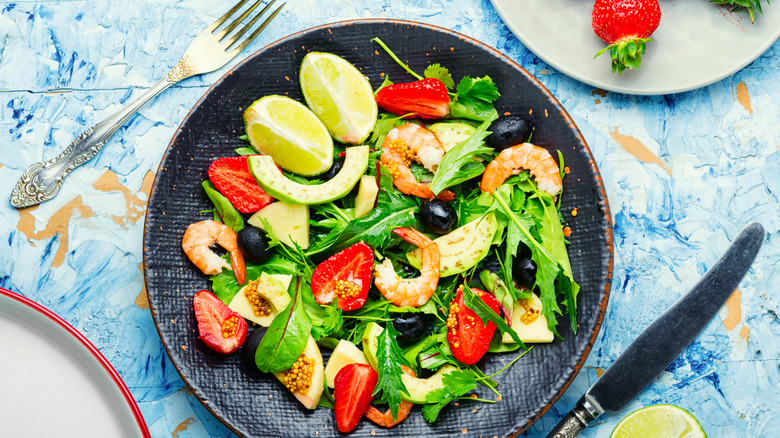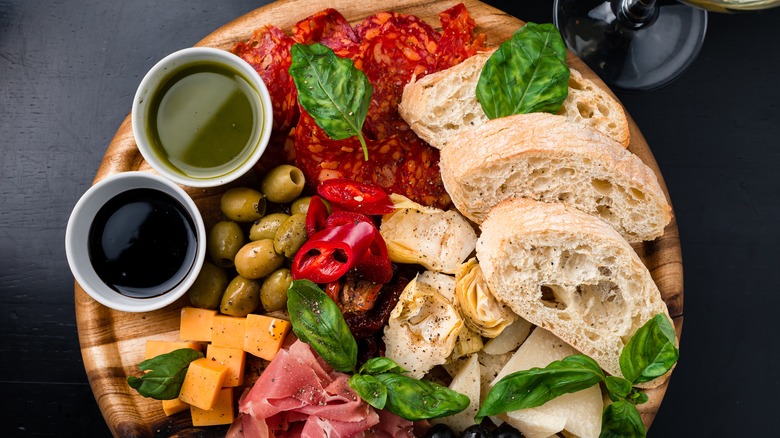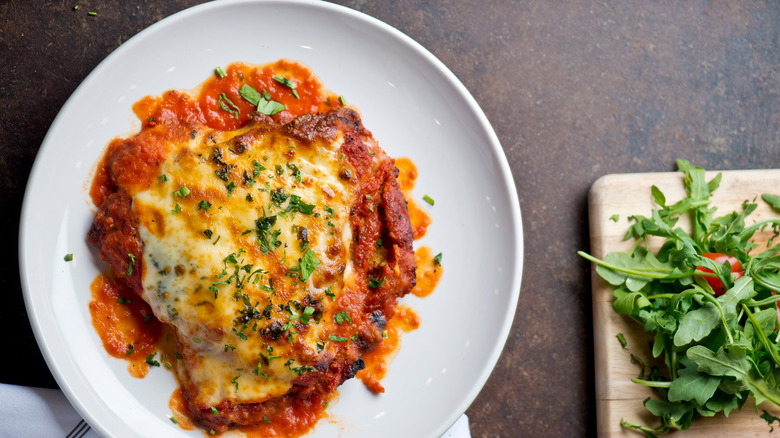12 Things To Know About Italian Cuisine
Italian food is arguably one of the most popular cuisines in the world and in America we love our pizza, pasta, and comforting parmigiana dishes (low carb diets, be damned!). But many of the "red sauce" entrees we favor are a far cry from the authentic dishes you'll find in Italy. As Italians immigrated to the U.S., many of their specialties became Americanized, due to the new terrain, food availability, and a new way of living. They brought along their recipes from home and soon a new way of eating was born.
Whether you're planning a foodie trip to Italy, or you just want to eat more like the Italians, there are plenty of customs and cultural differences to be aware of, from what time of day certain foods and beverages are consumed to the perfect digestivo that will help you wash it all down. Read on for 12 interesting facts about Italian food that will help you get to know and appreciate this bright, savory, and down-to-earth cuisine.
1. Pizza originated in Naples, Italy
Pizza is thought of by most people as the perfect food -– delicious, simple, and easy to eat on the go. You can find pizza just about everywhere, but did you know that the birthplace of pizza is in Italy's Campania region? The city of Naples was where it all started.
The Neapolitans needed food that was cheap and could be consumed quickly. A flatbread with toppings was sold by street vendors or at informal restaurants. This pizza was eaten for any meal and contained the same elements we enjoy today –- tomatoes, cheese, oil, anchovies, and garlic. Story has it that Italy's Queen Margherita's favorite variety was a pizza with soft cheese, tomatoes, and basil (thus the famous "Margherita pie" that's enjoyed around the world today).
Pizza found fans beyond the borders of Naples in the 1940s when immigrants brought it to the U.S. and put their own spin on it in cities such as New York, Boston, and Chicago. So the next time you order a Margherita pizza you'll know its splendid history!
2. Spaghetti and meatballs is not an Italian dish
Spaghetti and meatballs is such a popular delicacy, it's almost synonymous with Italian food for most Americans. It's available on every Italian American restaurant menu (especially on the kids' menu) and your grandma certainly made it for you on Sundays at her house. Meatballs and spaghetti is about as comforting as it gets when it comes to food. But this famous dish was actually invented in the U.S. by Italian immigrants.
The meatballs you'll find in Italy are a far cry from the giant breadcrumb-laden belly bombs you'll find at your local red and white checkered tablecloth restaurant in the U.S. Italy's meatballs are called polpettes but they are smaller than American meatballs and are eaten on their own, sometimes as an appetizer, sometimes with a savory sauce or in soup, such as Italian Wedding Soup. These bite-sized morsels are known in Italy as a feature of "peasant cooking" and can be made with any leftover meat (chicken, beef, lamb, or even veggies). They're also so easy to make that any home cook can do it (though your nonna did it best)! These meatballs are the perfect Sunday night (or anytime) dinner. How big you make them is of course up to you!
3. Italy is one of the world's top wine producers
According to a 2021 study via Statista, Italy, France, and Spain were the world's top three wine producers, with Italy coming in at the top spot. So why does so much great vino come from Italy? It's no doubt due to the climate, terrain, and soil quality. The temperatures in Italy simply lend to excellent wine production. In this perfect environment to create great wine, it's no wonder that wine is an everyday part of the Italians' lifestyle, enjoyed with friends and family at most meals and social occasions.
Wine tours are popular with vacationers to the country where families have produced wine for generations, tending the same lands and using the same methods as their predecessors. Whether it's red or white, there's a reason to raise your glass to this country for a toast to their exceptional wine. In fact, Italy, France, and Spain produced 53% of the world's wine in 2020, which means if you're drinking, chances are you're already drinking like an Italian. So next time you raise a glass of Chianti or Montepulciano, say "saluti!" and thank the Italians.
4. Northern Italians aren't big on pasta
The pasta-heavy dishes we think of when discussing Italian food in America are mainly from Southern Italy. But not all of Italy is focused on pasta and pizza (though we can understand the obsession). Food from the North focuses more on fish, cream, and butter sauces, as well as risotto or polenta instead of pasta. Osso buco, which is sliced veal sauteed with bone and marrow, is found in the region, as is vegetable soup with rice and bacon. A risotto made from rice that grows on the plains is a more frequent accompaniment than linguini or penne in the North.
When sampling Northern Italian cuisine, you're likely to be served game or wild fowl as your dinner. It's not unheard of to have rabbit or quail as a main dish. Seafood and shellfish are also popular delicacies from this area. You can bet that if it grows, lives, or swims locally, you'll find it on your table. Try making this perfect osso buco recipe from Sirio NYC's chef Massimo Bebber or this creamy mushroom risotto.
5. You shouldn't order a cappuccino in Italy after 11 a.m.
While Americans love their coffee at any hour of the day, Italians' coffee drinking behaviors are more finely attuned to the time of day, the environment for drinking coffee, and the activity they are doing. According to Cappuccino is a breakfast drink in Italy, so don't order one after 11 a.m., lest you look like a tourist. A macchiato is viewed as an afternoon pick-me-up to the Italians. Espresso is best enjoyed as an after-dinner drink that perfectly ends a meal.
And while you may love to get your Dunkin' on the go, this is not the way Italians drink coffee. And while we're at it, they certainly would not add whipped cream and flavored syrups to their coffees, or slurp them down through straws in gargantuan, calorie-laden, over-sized cups that contain enough calories for one day. An Italian coffee is best taken at a bar, standing up, since it's usually a small amount that doesn't require sitting down (and paying a higher price for table service). Drinking coffee is more of an art than something to guzzle down, so pay attention to the delicious aroma of espresso and enjoy it like the Italians do.
6. Garlic bread is not traditional Italian food
You may enjoy slathering a loaf of Italian bread with butter and baking it with some chopped garlic, but know that this is an American delicacy. In Italy, bread is served plain -– only in America was the tradition of buttering bread and roasting it or grilling it with garlic on top invented, becoming an Italian American tradition.
According to chef Lidia Bastianich, garlic bread can be overwhelming to the Italian palate. In Italy, garlic is used in cooking, but not necessarily as a topping. The closest thing you'll find in Italy to garlic bread is the more elegant yet simple bruschetta. It can be made with a variety of toppings, such as cherry tomatoes, goat cheese, white beans, and even steak and eggs –- the possibilities are endless. Bruschetta can be served as an appetizer or as a lighter meal (with some vino of course). Be sure to use a sturdy bread and slice it on an angle for a more elegant appearance, and to support all those savory toppings.
7. If you want to drink like the Italians, try limoncello
Limoncello, a bright and delicious liqueur, was invented over 100 years ago on the Amalfi Coast on Capri and Sorrento where the world's best lemons are bountiful. Some stories say that it was first made at an inn on Capri, while other origin stories place it back to the Middle Ages when fishermen and farmers would imbibe in order to make the morning's work more tolerable.
Your best bet is to enjoy it after a delicious meal –- and ideally, it should be made with lemons from the Amalfi Coast since these thick-skinned citrus fruits produce such a fragrant and intoxicating aroma. If you can't make it to Italy, you can make limoncello at home with lemons, vodka, and sugar. While it takes 40 days to macerate, you'll be well on your way to an amazing taste sensation. It's perfect for summer sipping but also works well to warm up on winter days. Serve it as a shot, ice cold, and try your best not to have a second one.
8. Italians eat salad after the main course
Unfortunately, the Italian practice of eating salad after the main dish won't help you to eat fewer carbs, but to be like a true Italian don't eat your salad first — save it for after the entrée to help with digestion. In fact, most Europeans take their salad after the entrée, unlike Americans who start a meal with a bowlful of greens. The roughage from your lettuce and vegetables will keep things moving along so it does serve a purpose.
The Italians may be onto something by saving their greens for last — this way, their main dish won't get cold while they're eating salad. While Italians typically don't consider a salad to be a full meal the way Americans do, that doesn't mean their salads are lacking in taste or variety. Often simple and colorful, a great Italian salad will make use of the freshest, seasonal, local ingredients.
Want to keep your dinner on the healthy side? This classic, Italian salad is made of simple, fresh ingredients and is great either before or after your pappardelle ragu. Whatever goes into your salad is up to you, but be sure to choose in-season ingredients. True Italians know that this is the way to make sure your salad is actually delicious and anything but sad.
9. Start your meal with antipasto
Italian meals begin with antipasto, a course meant to whet your appetite. Depending on the region, this dish can be comprised of olives, mushrooms, peppers, cured meats, and of course cheese. This traditional first course can be even more elaborate in restaurants where shellfish, seafood, and stuffed mushrooms may be added to the plate.
Antipasto isn't just delicious — it actually has a purpose. Antipasto platters stimulate the appetite and prepare your palate for the other amazing foods to come. The colors and food pairings are just as important as the taste, as we eat with our eyes first.
For your next dinner party, make an antipasto platter filled with tasty morsels. Marinated goat cheese with olives sounds like a dream come true and an insalata tricolore comprised of greens, tomatoes, and bresaola and thin slices of air-dried, salted beef, will have your mouth watering.
10. Chicken parm is an American invention
A breaded cutlet smothered with tomato sauce and mozzarella cheese may be the ultimate comfort food, but the dish was invented in the U.S., not Italy. The dish may have originated from eggplant parm in Italy, where pieces of the vegetable are breaded, fried, and smothered with cheese (now that's a recipe for bliss). As Italians immigrated to the U.S. the dish was made with chicken and a new tradition was born. Chicken parm, as we lovingly refer to it, took off in the 1950s and quickly became a household favorite. So even though it may not be authentic Italian cuisine, chicken parm rightfully has a spot in Italian American foods that we just can't get enough of.
Of course, there are other iterations to be found on most Italian-American restaurant menus, including veal parmigiana and even shrimp parmigiana (look, we don't object to smothering anything in mozzarella, so why not?).
11. Tiramisu is popular, but at home Italians eat fruit, ices, and biscotti
When you think of classic Italian desserts, indulgent pastries like cannoli, tiramisu, or cassatas (ice cream cake) come to mind. But if you want to eat like an Italian, you probably won't be gorging on elaborate desserts, at least not every day. The Italians save the fancy desserts for special occasions and are more likely to end a meal with something simple and light. Biscotti, ices, and fresh fruit fit the bill, especially when they are dining at home.
Biscotti, which means "twice baked," was a dessert designed to hold up well when sailors took it to sea. You can make some in your own home and eat it right at the table. This peppermint biscotti is dipped in rich chocolate and oh-so-sweet, while another made with walnuts and gorgonzola is on the savory side.
Want to make that tiramisu anyway? Check out this beginner's guide that uses six classic ingredients including sugar, eggs, espresso, mascarpone, cocoa powder, and savoiardi. Alcohol is also typically incorporated into the dessert (dark rum is the most popular choice but amaretto or marsala wine work great too) to give it a splendid, boozy kick.
12. A panini is a whole other level of sandwich
Traditionally made with Italian bread such as ciabatta, a panini consists of meat, cheese, and other delicious ingredients, often grilled. These sandwiches had a moment when everyone and their mother had a panini press at home, but they are much more than a passing trend.
A panini is the perfect vehicle for the freshest, simplest ingredients. After all is there anything better in life than a sandwich with fresh mozzarella, sundried tomatoes, and pesto? Once you try this simple yet elegant sandwich there will be no going back to a sub or a hoagie ever again!
There are so many varieties of panini to make that you'll never get bored eating them. Learn how to make a caprese panini, or one with prosciutto, roasted red pepper, and basil. Portobello mushrooms, chicken cutlets, and other meats also go well in these sandwiches. Eat one today to feel like a true Italian.
